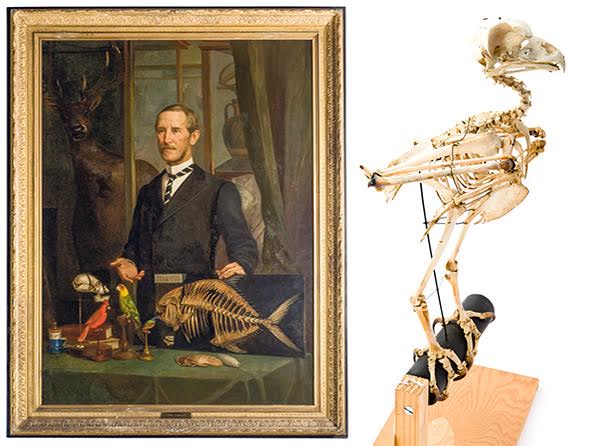
An 1894 portrait shows Gabriel E. Manigault with artifacts and specimens he collected while curator of The Charleston Museum from 1873 to 1899; an American kestrel skeleton from the exhibit that’s on display through January 6. Images (skeleton & oil painting of Gabriel E. Manigault by John Stolle) courtesy of The Charleston Museum
August 17, 2016
The Skeleton Crew
The Charleston Museum’s 19th-century curator, Gabriel E. Manigault, masterfully prepared dozens of skeletons now on view in a special exhibit
written by Anna Evans
In January 1880, a right whale—exactly 40 feet and four inches long—swam into Charleston Harbor and couldn’t find his way back out to sea. After several days, a brigade of rowboats, tugboats, and sailing crafts set out to capture and kill the animal—a task accomplished after an hours-long chase. The carcass was exhibited to the citizens and then given to Gabriel E. Manigault, curator of the College of Charleston Museum. Manigault “articulated” the whale, cleaning the bones, then drilling holes in them and wiring them together to form a complete skeleton. This he hung from the ceiling of the museum’s main hall.
Modern-day visitors to that institution—now called The Charleston Museum and located on Meeting Street—are greeted by that very same behemoth. While it’s hard not to cringe at the tale of the whale’s demise, the museum’s curator of natural history, Matthew Gibson, notes, “A lot of what we know today about vertebrae anatomy comes from early naturalists’ collection process of going out and capturing animals.”
Manigault himself traveled the globe collecting specimens to articulate (he studied the art form at the School of Natural History in Paris) even before stepping into his role as curator in 1873. The Charleston Museum still has about 100 of those carefully mounted creatures, and this summer, a selection went on display in the exhibit “Skeletons in the Closet: Exploring Skeletal Anatomy.” Through January 6, visitors will find the main lobby filled with amphibians, reptiles, birds, and mammals (even a lion and wolverine) as the museum seeks to build excitement for its new Natural History Gallery set to open in August 2017.
“In Manigault’s arrangement of the skeletons, you can see that he was trying to tell a story, to really show how the animal’s body functioned,” says Gibson. “For example, he cut the shell of a yellow-bellied slider turtle and hinged it open so viewers can see how the backbone is fused to the shell.”
Why not pick a steamy August day to experience some of this native son’s stories? Though crafted decades ago, they’re ever-so relevant today.
To find details on visiting The Charleston Museum, click here.
Want to read other intriguing stories about Charleston’s past? Click here.
|
 |